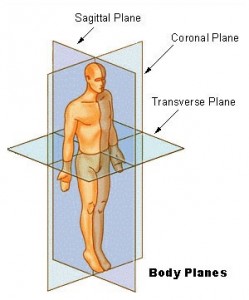We spend the first few years of our lives learning the basics of human movement through trial and error. First mastering eye and neck movements before progressing to rolling, sitting, crawling and then eventually kneeling to standing. Each of these phases requires a certain level of mobility, co- ordination and strength in order to progress to the next level. The human body achieves this by moving as a unit, with many of our joints and muscles needing to move in multiple directions.
Whenever we move, our joints and muscles always go through the three planes of movement:
- Sagittal plane

- Frontal plane
- Transverse plane
Unfortunately we are slowly undoing all this good work, as we fall victim to our modern way of living, which involves a large portion of sitting, eg; sitting at the office desk all week.
Our exercises and day to day tasks now largely focus solely on the sagittal (forward and back) plane.
In order to get back to what nature intended and improve our flexibility, strength and fitness we need to incorporate the other planes of movement. For example we commonly perform our lunges to the front, but tend to forget we can and need to lunge to the side and with a rotation, as our joints would experience during real life movement.
The additional planes also adds variability to our routine, better prepares our joints and muscles for different movements and decreases our chances of injury.
Once you have taught your body to move in the three planes of motion, you can then move to work on building on that to increase fitness and strength.

